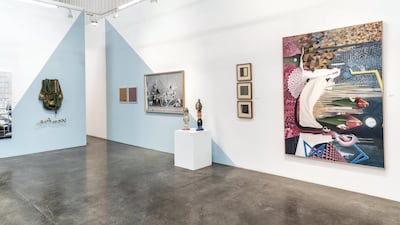If I had a penny for every time someone told me there should be more critical writing about art, I’d be a very rich woman. And as someone who has spent the better part of two decades as a critic, it’s hard not to take this observation personally – like the time London’s Institute of Contemporary Art invited me and three others to a panel titled “The Trouble with Art Criticism”. Did they not think that one through?
The feeling that art criticism has ceased to be, well, critical is not limited to the UAE, but it feels particularly acute here: part of the culture of boosterism that manufactures genuine excitement over the opening of a new cheese bar. For a while, this enthusiasm seemed necessary to support the growing art scene. What mattered was less the calibre of exhibition or performance, but the development of an art infrastructure in which to hold these events. Others ascribe the lack of critical writing to deficiencies within the scene: there are few proper art critics, and writing appears here mainly in newspapers and a few glossy magazines, rather than the quasi-academic journals that exist elsewhere. But art critics in the UAE aren't half bad. Antonia Carver, head of Art Jameel, and Myrna Ayad, outgoing director of Art Dubai, both cut their teeth in the writing game.
And I've published my fair share of critical articles, in these pages and elsewhere, about art in the UAE. The result? I've been snubbed at soirees, disinvited from dinners, cold-shouldered at cocktail receptions. Still, these reviews haven't made a dent in the impression that art writing is unilaterally positive. The issue is larger than just shallow reporting.
What is the problem that people think would be solved by a culture of criticism?
The obvious answer is: a stronger art scene. With more robust critique, art world would stop validating mediocre expression or rubber-stamping derivative works with an “A” for effort. It would enable art to interrogate itself and important social issues. Critics, this thinking runs, need to hold artists’ feet to the fire. Now, I would love for a more ambitious art world to emerge, but I’m not sure more stringent criticism is the means towards it. If anything, the answer is art education: better educated people make better art and provide better critiques. And, sadly for myself, I don’t think criticism still wields that much power. The critic’s importance has long been supplanted by that of the curator. Everyone knows artists do better to curry favour among biennale organisers than among those of us who tromp along to the openings, notebooks in hand.
________________________
Read more from Opinion:
Jonathan Cook: Israel is bulldozing Khan Al Ahmar – and with it the two-state solution
Sholto Byrnes: Najib Razak has already been found guilty in Malaysia's court of public opinion
Peter Hellyer: Iceberg project belongs firmly in the realm of fiction
________________________
Rather, I suspect that the lament for a culture of critique comes from a disconnect between art and its public. Part of this is structural. To put it quite plainly, it’s not always clear how a work of art is operating in a gallery. You need to know its backstory, the artist’s intentions, where it was taken from or how it was made in order to fully understand it. Readers want opinions while you’re stuck explaining: it’s no wonder you risk not looking like an honest broker.
And more importantly, what happens with the opinions you write? They mean nothing if they’re not picked up and continued within a public discussion. In an ideal world, an artist would stage an exhibition, a critic would thoughtfully review it and the public – artistic and general – would build on the critic’s judgements in serious debates over the work. It would matter if the work were good or bad, and the review would open up genuine discussion. A thought-provoking art review is a handover to the public to continue a conversation.
But this kind of greater engagement has to be nurtured, which is why forums for discussion have lately become so important in the UAE – whether in the extraordinary popularity of the pedestrianised spaces of Alserkal Avenue in Dubai, Warehouse421's rumoured plans for an Abu Dhabi art district, or the synchronicities among the many art organisations in Sharjah. Especially in this privatised, car-divided Gulf, we need to work harder at providing actual, physical spaces for coming together.
In the art world, a critical culture has to be normalised, so that negative feedback isn’t seen as a sensational one-off. And beyond the art bubble, people feel a lack of engagement with art production and exhibition. They want a critical community around art that has a determining say in what works are shown and supported – and they also want artists to respond to the needs that impact their individual lives. They want to be included within art culture. That’s not something to easily write off.
Melissa Gronlund, author of Contemporary Art and Digital Culture, is visual arts writer at The National


